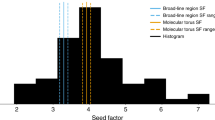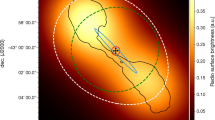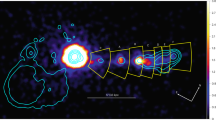Abstract
The most powerful persistent accelerators in the Universe are jetted active galaxies. Blazars, galaxies whose jets are directed towards Earth, dominate the extragalactic γ-ray sky. Still, most of the highest-energy particle accelerators probably elude detection. These extreme blazars, whose radiated energy can peak beyond 10 TeV, are ideal targets to study particle acceleration and radiative processes, and may provide links to cosmic rays and astrophysical neutrinos. The growing number of extreme blazars observed at teraelectronvolt energies has been critical for the emergence of γ-ray cosmology, including measurements of the extragalactic background light, tight bounds on the intergalactic magnetic field, and constraints on exotic physics at energies inaccessible with human-made accelerators. Tremendous progress has been achieved over the past decade, which bodes well for the future, particularly with the deployment of the Cherenkov Telescope Array.
This is a preview of subscription content, access via your institution
Access options
Access Nature and 54 other Nature Portfolio journals
Get Nature+, our best-value online-access subscription
$29.99 / 30 days
cancel any time
Subscribe to this journal
Receive 12 digital issues and online access to articles
$119.00 per year
only $9.92 per issue
Buy this article
- Purchase on Springer Link
- Instant access to full article PDF
Prices may be subject to local taxes which are calculated during checkout




Similar content being viewed by others
Data availability
All data presented in this study are included in this published article and its supplementary information files.
References
Padovani, P. et al. Active galactic nuclei: what’s in a name? Astron. Astrophys. Rev. 25, 2 (2017).
Urry, C. M. & Padovani, P. Unified schemes for radio-loud active galactic nuclei. Publ. Astron. Soc. Pac. 107, 803–845 (1995).
Tavecchio, F., Ghisellini, G., Ghirlanda, G., Foschini, L. & Maraschi, L. TeV BL Lac objects at the dawn of the Fermi era. Mon. Not. R. Astron. Soc. 401, 1570–1586 (2010).
Padovani, P. & Giommi, P. The connection between X-ray- and radio-selected BL Lacertae objects. Astrophys. J. 444, 567–581 (1995).
Ghisellini, G. Extreme blazars. Astropart. Phys. 11, 11–18 (1999).
Aharonian, F. et al. A low level of extragalactic background light as revealed by γ-rays from blazars. Nature 440, 1018–1021 (2006).
Costamante, L. et al. Extreme synchrotron BL Lac objects. Stretching the blazar sequence. Astron. Astrophys. 371, 512–526 (2001).
Costamante, L. et al. The NuSTAR view on hard-TeV BL Lacs. Mon. Not. R. Astron. Soc. 477, 4257–4268 (2018).
Pian, E. et al. BeppoSAX observations of unprecedented synchrotron activity in the BL Lacertae object Markarian 501. Astrophys. J. Lett. 492, L17 (1998).
Giommi, P., Padovani, P. & Perlman, E. Detection of exceptional X-ray spectral variability in the TeV BL Lac 1ES 2344+514. Mon. Not. R. Astron. Soc. 317, 743–749 (2000).
Wakely, S. P. & Horan, D. TeVCat: an online catalog for very high energy gamma-ray astronomy. In Proc. 30th International Cosmic Ray Conference ICRC2007 Vol. 3 (eds Caballero, R. et al.) 1341–1344 (2008).
Ahnen, M. L. et al. First multi-wavelength campaign on the gamma-ray-loud active galaxy IC 310. Astron. Astrophys. 603, A25 (2017).
Aharonian, F. et al. New constraints on the mid-IR EBL from the HESS discovery of VHE γ-rays from 1ES 0229+200. Astron. Astrophys. 475, L9–L13 (2007).
Acciari, V. A. et al. Discovery of variability in the very high energy γ-ray emission of 1ES 1218+304 with VERITAS. Astrophys. J. 709, L163–L167 (2010).
Aliu, E. et al. A three-year multi-wavelength study of the very-high-energy γ-ray blazar 1ES 0229+200. Astrophys. J. 782, 13 (2014).
Ahnen, M. L. et al. Extreme HBL behavior of Markarian 501 during 2012. Astron. Astrophys. 620, A181 (2018).
Archambault, S. et al. VERITAS detection of γ-ray flaring activity from the BL Lac object 1ES 1727+502 during bright moonlight observations. Astrophys. J. 808, 110 (2015).
The Fermi-LAT Collaboration Fermi Large Area Telescope fourth source catalog. Preprint at https://arxiv.org/abs/1902.10045 (2019).
Chang, Y.-L., Arsioli, B., Giommi, P., Padovani, P. & Brandt, C. The 3HSP catalogue of extreme and high synchrotron peaked blazars. Astron. Astrophys. 632, A77 (2019).
Paliya, V. S., Domínguez, A., Ajello, M., Franckowiak, A. & Hartmann, D. Fermi-LAT stacking analysis technique: an application to extreme blazars and prospects for their CTA detection. Astrophys. J. Lett. 882, L3 (2019).
Padovani, P., Giommi, P., Landt, H. & Perlman, E. S. The Deep X-Ray Radio Blazar Survey. III. Radio number counts, evolutionary properties, and luminosity function of blazars. Astrophys. J. 662, 182–198 (2007).
Ghisellini, G., Righi, C., Costamante, L. & Tavecchio, F. The Fermi blazar sequence. Mon. Not. R. Astron. Soc. 469, 255–266 (2017).
Giommi, P. et al. A simplified view of blazars: clearing the fog around long-standing selection effects. Mon. Not. R. Astron. Soc. 420, 2899–2911 (2012).
Blandford, R. & Eichler, D. Particle acceleration at astrophysical shocks: a theory of cosmic ray origin. Phys. Rep. 154, 1–75 (1987).
Sironi, L. & Spitkovsky, A. Relativistic reconnection: an efficient source of non-thermal particles. Astrophys. J. Lett. 783, L21 (2014).
Schlickeiser, R. Cosmic-ray transport and acceleration. I. Derivation of the kinetic equation and application to cosmic rays in static cold media. Astrophys. J. 336, 243 (1989).
Rieger, F. M. An introduction to particle acceleration in shearing flows. Galaxies 7, 78 (2019).
Kagan, D., Sironi, L., Cerutti, B. & Giannios, D. Relativistic magnetic reconnection in pair plasmas and its astrophysical applications. Space Sci. Rev. 191, 545–573 (2015).
Katarzyński, K., Ghisellini, G., Tavecchio, F., Gracia, J. & Maraschi, L. Hard TeV spectra of blazars and the constraints to the infrared intergalactic background. Mon. Not. R. Astron. Soc. 368, L52–L56 (2006).
Ghisellini, G., Tavecchio, F. & Chiaberge, M. Structured jets in TeV BL Lac objects and radiogalaxies. Implications for the observed properties. Astron. Astrophys. 432, 401–410 (2005).
Chhotray, A. et al. On radiative acceleration in spine-sheath structured blazar jets. Mon. Not. R. Astron. Soc. 466, 3544–3557 (2017).
Lefa, E., Rieger, F. M. & Aharonian, F. Formation of very hard gamma-ray spectra of blazars in leptonic models. Astrophys. J. 740, 64 (2011).
Böttcher, M., Dermer, C. D. & Finke, J. D. The hard VHE γ-ray emission in high-redshift TeV blazars: comptonization of cosmic microwave background radiation in an extended jet? Astrophys. J. 679, L9 (2008).
Tavecchio, F., Ghisellini, G., Ghirlanda, G., Costamante, L. & Franceschini, A. The hard TeV spectrum of 1ES 0229+200: new clues from Swift. Mon. Not. R. Astron. Soc. 399, L59–L63 (2009).
Tramacere, A., Massaro, E. & Taylor, A. M. Stochastic acceleration and the evolution of spectral distributions in synchro-self-compton sources: a self-consistent modeling of blazars’ flares. Astrophys. J. 739, 66 (2011).
Cerruti, M., Zech, A., Boisson, C. & Inoue, S. A hadronic origin for ultra-high-frequency-peaked BL Lac objects. Mon. Not. R. Astron. Soc. 448, 910–927 (2015).
Aharonian, F. A. TeV gamma rays from BL Lac objects due to synchrotron radiation of extremely high energy protons. N. Astron. 5, 377–395 (2000).
Murase, K., Dermer, C. D., Takami, H. & Migliori, G. Blazars as ultra-high-energy cosmic-ray sources: implications for TeV gamma-ray observations. Astrophys. J. 749, 63 (2012).
Essey, W., Kalashev, O. E., Kusenko, A. & Beacom, J. F. Secondary photons and neutrinos from cosmic rays produced by distant blazars. Phys. Rev. Lett. 104, 141102 (2010).
Taylor, A. M., Vovk, I. & Neronov, A. Extragalactic magnetic fields constraints from simultaneous GeV-TeV observations of blazars. Astron. Astrophys. 529, A144 (2011).
Dzhatdoev, T. A., Khalikov, E. V., Kircheva, A. P. & Lyukshin, A. A. Electromagnetic cascade masquerade: a way to mimic γ-axion-like particle mixing effects in blazar spectra. Astron. Astrophys. 603, A59 (2017).
Tavecchio, F. On the hadronic cascade scenario for extreme BL Lacs. Mon. Not. R. Astron. Soc. 438, 3255–3262 (2014).
Oikonomou, F., Murase, K. & Kotera, K. Synchrotron pair halo and echo emission from blazars in the cosmic web: application to extreme TeV blazars. Astron. Astrophys. 568, A110 (2014).
IceCube Collaboration. et al. Multimessenger observations of a flaring blazar coincident with high-energy neutrino IceCube-170922A. Science 361, eaat1378 (2018).
Aartsen, M. G. et al. Neutrino emission from the direction of the blazar TXS 0506+056 prior to the IceCube-170922A alert. Science 361, 147–151 (2018).
Gao, S., Fedynitch, A., Winter, W. & Pohl, M. Modelling the coincident observation of a high-energy neutrino and a bright blazar flare. Nat. Astron. 3, 88–92 (2019).
Cerruti, M. et al. Leptohadronic single-zone models for the electromagnetic and neutrino emission of TXS 0506+056. Mon. Not. R. Astron. Soc. 483, L12–L16 (2019).
Keivani, A. et al. A multimessenger picture of the flaring blazar TXS 0506+056: implications for high-energy neutrino emission and cosmic-ray acceleration. Astrophys. J. 864, 84 (2018).
Liu, R.-Y. et al. Hadronuclear interpretation of a high-energy neutrino event coincident with a blazar flare. Phys. Rev. D 99, 063008 (2019).
Tavecchio, F., Ghisellini, G. & Guetta, D. Structured jets in BL Lac objects: efficient PeV neutrino factories? Astrophys. J. 793, L18 (2014).
Padovani, P., Petropoulou, M., Giommi, P. & Resconi, E. A simplified view of blazars: the neutrino background. Mon. Not. R. Astron. Soc. 452, 1877–1887 (2015).
Guilbert, P. W., Fabian, A. C. & Rees, M. J. Spectral and variability constraints on compact sources. Mon. Not. R. Astron. Soc. 205, 593–603 (1983).
Arons, J. Pulsar wind nebulae as cosmic pevatrons: a current sheet’s tale. Space Sci. Rev. 173, 341–367 (2012).
Hillas, A. M. The origin of ultra-high-energy cosmic rays. Annu. Rev. Astron. Astrophys. 22, 425–444 (1984).
Aab, A. et al. Depth of maximum of air-shower profiles at the Pierre Auger Observatory. II. Composition implications. Phys. Rev. D 90, 122006 (2014).
Taylor, A. M., Ahlers, M. & Hooper, D. Indications of negative evolution for the sources of the highest energy cosmic rays. Phys. Rev. D 92, 063011 (2015).
Ajello, M. et al. The cosmic evolution of Fermi BL Lacertae objects. Astrophys. J. 780, 73 (2014).
Taylor, A. M., Ahlers, M. & Aharonian, F. A. Need for a local source of ultrahigh-energy cosmic-ray nuclei. Phys. Rev. D 84, 105007 (2011).
Lemoine, M. & Waxman, E. Anisotropy vs chemical composition at ultra-high energies. J. Cosmol. Astropart. Phys. 2009, 009 (2009).
Matthews, J. H., Bell, A. R., Blundell, K. M., Araudo, A. T., Fornax, A. & Centaurus, A. and other radio galaxies as sources of ultrahigh energy cosmic rays. Mon. Not. R. Astron. Soc. 479, L76–L80 (2018).
Alves Batista, R. et al. Open questions in cosmic-ray research at ultrahigh energies. Front. Astron. Space Sci. 6, 23 (2019).
Hauser, M. G. & Dwek, E. The cosmic infrared background: measurements and implications. Annu. Rev. Astron. Astrophys. 39, 249–307 (2001).
Franceschini, A. & Rodighiero, G. The extragalactic background light revisited and the cosmic photon-photon opacity. Astron. Astrophys. 603, A34 (2017).
Biteau, J. & Williams, D. A. The extragalactic background light, the Hubble constant, and anomalies: conclusions from 20 years of TeV gamma-ray observations. Astrophys. J. 812, 60 (2015).
Desai, A. et al. A GeV–TeV measurement of the extragalactic background light. Astrophys. J. Lett. 874, L7 (2019).
Ackermann, M. et al. The imprint of the extragalactic background light in the gamma-ray spectra of blazars. Science 338, 1190–1192 (2012).
H.E.S.S. Collaboration Measurement of the extragalactic background light imprint on the spectra of the brightest blazars observed with H.E.S.S. Astron. Astrophys. 550, A4 (2013).
H.E.S.S. Collaboration Measurement of the EBL spectral energy distribution using the VHE γ-ray spectra of H.E.S.S. blazars. Astron. Astrophys. 606, A59 (2017).
Acciari, V. A. et al. Measurement of the extragalactic background light using MAGIC and Fermi-LAT gamma-ray observations of blazars up to z = 1. Mon. Not. R. Astron. Soc. 486, 4233–4251 (2019).
Durrer, R. & Neronov, A. Cosmological magnetic fields: their generation, evolution and observation. Astron. Astrophys. Rev. 21, 62 (2013).
Vafin, S., Rafighi, I., Pohl, M. & Niemiec, J. The electrostatic instability for realistic pair distributions in blazar/EBL cascades. Astrophys. J. 857, 43 (2018).
Neronov, A. & Vovk, I. Evidence for strong extragalactic magnetic fields from fermi observations of TeV blazars. Science 328, 73–75 (2010).
Ackermann, M. et al. The search for spatial extension in high-latitude sources detected by the Fermi Large Area Telescope. Astrophys. J. Suppl. 237, 32 (2018).
H.E.S.S. Collaboration Search for extended γ-ray emission around AGN with H.E.S.S. & Fermi-LAT. Astron. Astrophys. 562, A145 (2014).
Archambault, S. et al. Search for magnetically broadened cascade emission from blazars with VERITAS. Astrophys. J. 835, 288 (2017).
Liberati, S. Tests of Lorentz invariance: a 2013 update. Class. Quantum Gravity 30, 133001 (2013).
de Angelis, A., Galanti, G. & Roncadelli, M. Relevance of axionlike particles for very-high-energy astrophysics. Phys. Rev. D 84, 105030 (2011).
Abdalla, H. et al. The 2014 TeV γ-ray flare of Mrk 501 seen with H.E.S.S.: temporal and spectral constraints on Lorentz invariance violation. Astrophys. J. 870, 93 (2019).
Lang, R. G., Martínez-Huerta, H. & de Souza, V. Improved limits on Lorentz invariance violation from astrophysical gamma-ray sources. Phys. Rev. D 99, 043015 (2019).
Abramowski, A. et al. Constraints on axionlike particles with H.E.S.S. from the irregularity of the PKS 2155-304 energy spectrum. Phys. Rev. D 88, 102003 (2013).
Galanti, G., Tavecchio, F., Roncadelli, M. & Evoli, C. Blazar VHE spectral alterations induced by photon-ALP oscillations. Mon. Not. R. Astron. Soc. 487, 123–132 (2019).
Merloni, A. et al. eROSITA science book: mapping the structure of the energetic Universe. Preprint at https://arxiv.org/abs/1209.3114 (2012).
Krawczynski, H. et al. Astro2020 science white paper: Using X-ray polarimetry to probe the physics of black holes and neutron stars. Preprint at https://arxiv.org/abs/1904.09313 (2019).
de Angelis, A. et al. Science with e-ASTROGAM. A space mission for MeV–GeV gamma-ray astrophysics. J. High. Energy Astrophys. 19, 1–106 (2018).
Cherenkov Telescope Array Consortium et al. Science with the Cherenkov Telescope Array (World Scientific, 2019).
Bai, X. et al. The Large High Altitude Air Shower Observatory (LHAASO) science white paper. Preprint at https://arxiv.org/abs/1905.02773 (2019).
Albert, A. et al. Science case for a wide field-of-view very-high-energy gamma-ray observatory in the Southern Hemisphere. Preprint at https://arxiv.org/abs/1902.08429 (2019).
Sironi, L., Keshet, U. & Lemoine, M. Relativistic shocks: particle acceleration and magnetization. Space Sci. Rev. 191, 519–544 (2015).
Wong, K., Zhdankin, V., Uzdensky, D. A., Werner, G. R. & Begelman, M. C. First-principles demonstration of diffusive particle acceleration in kinetic simulations of relativistic plasma turbulence. Preprint at https://arxiv.org/abs/1901.03439 (2019).
Paul, J., Wei, J., Basa, S. & Zhang, S.-N. The Chinese–French SVOM mission for gamma-ray burst studies. C. R. Phys. 12, 298–308 (2011).
Aartsen, M. G. et al. IceCube-Gen2: a vision for the future of neutrino astronomy in Antarctica. Preprint at https://arxiv.org/abs/1412.5106 (2014).
Adrián-Martínez, S. et al. Letter of intent for KM3NeT 2.0. J. Phys. G 43, 084001 (2016).
The Pierre Auger Collaboration The Pierre Auger Observatory upgrade — preliminary design report. Preprint at https://arxiv.org/abs/1604.03637 (2016).
Sagawa, H. Telescope Array extension: TAx4. Proc. Sci. 236, 657 (2016).
Silva, L., Granato, G. L., Bressan, A. & Danese, L. Modeling the effects of dust on galactic spectral energy distributions from the ultraviolet to the millimeter band. Astrophys. J. 509, 103–117 (1998).
Scarpa, R. et al. The Hubble Space Telescope Survey of BL Lacertae objects. I. Surface brightness profiles, magnitudes, and radii of host galaxies. Astrophys. J. 532, 740–815 (2000).
Aharonian, F. A. et al. The time averaged TeV energy spectrum of MKN 501 of the extraordinary 1997 outburst as measured with the stereoscopic Cherenkov telescope system of HEGRA. Astron. Astrophys. 349, 11–28 (1999).
Tavecchio, F. et al. Theoretical implications from the spectral evolution of Markarian 501 observed with BeppoSAX. Astrophys. J. 554, 725–733 (2001).
Ghisellini, G., Celotti, A. & Costamante, L. Low power BL Lacertae objects and the blazar sequence. Clues on the particle acceleration process. Astron. Astrophys. 386, 833–842 (2002).
Tavecchio, F. & Bonnoli, G. On the detectability of Lorentz invariance violation through anomalies in the multi-TeV γ-ray spectra of blazars. Astron. Astrophys. 585, A25 (2016).
Acknowledgements
E.Prandini has received funding from the European Union’s Horizon2020 research and innovation programme under the Marie Sklodowska–Curie grant agreement no. 664931. E.Pueschel acknowledges the Young Investigators Program of the Helmholtz Association. F.T. acknowledges contribution from the grant INAF CTA–SKA ‘Probing particle acceleration and γ-ray propagation with CTA and its precursors’ and the INAF Main Stream project ‘High-energy extragalactic astrophysics: toward the Cherenkov Telescope Array’. This Perspective is the result of several fruitful discussions raised during the meeting eXtreme19 (22–25 January 2019, Padova, Italy). The authors, as chairs of the scientific committee and review speakers, thank all the participants of the meeting: C. Arcaro, B. Balmaverde, U. Barres de Almeida, E. Benítez, D. Bernard, E. Bernardini, M. Boettcher, S. Boula, A. Caccianiga, C. Casadio, I. Christie, A. De Angelis, L. Di Gesu, A. di Matteo, I. Donnarumma, M. Doro, T. Dzhatdoev, V. Fallah Ramazani, R. Ferrazzoli, I. Florou, L. Foffano, L. Foschini, N. I. Fraija, A. Franceschini, G. Galanti, M. Gonzalez, O. Gueta, O. Hervet, S. Kerasioti, F. Krauss, M. Kreter, G. La Mura, R. Lico, R. Lopez Coto, M. Lucchini, M. Mallamaci, M. Manganaro, A. Marinelli, M. Mariotti, K. Nalewajko, E. Nokhrina, F. Oikonomou, L. Olivera-Nieto, S. Paiano, V. Paliya, D. Paneque, Z. Pei, C. Perennes, S. Rainò, P. Romano, A. Sharma, G. Sigl, C. Sinnis, P. Soffitta, A. Spolon, B. Sversut Arsioli, A. Tramacere, S. Vercellone, V. Vittorini and H. Xiao.
Author information
Authors and Affiliations
Contributions
J.B. and E.Prandini coordinated the work and mostly contributed to the introduction and ‘Perspectives’ section. L.C. and P.P. mostly contributed to the ‘Extreme observational properties’ section. M.L., E.R., A.T. and A.Z. mostly contributed to the ‘The challenge of modelling extreme blazars’ section. E.Pueschel and F.T. mostly contributed to the ‘Extreme blazars and tests of γ-ray propagation’ section. All authors discussed the material and contributed to the writing of the manuscript.
Corresponding authors
Ethics declarations
Competing interests
The authors declare no competing interests.
Additional information
Peer review information Nature Astronomy thanks Giacomo Bonnoli, James Matthews and Fumio Takahara for their contribution to the peer review of this work.
Publisher’s note Springer Nature remains neutral with regard to jurisdictional claims in published maps and institutional affiliations.
Rights and permissions
About this article
Cite this article
Biteau, J., Prandini, E., Costamante, L. et al. Progress in unveiling extreme particle acceleration in persistent astrophysical jets. Nat Astron 4, 124–131 (2020). https://doi.org/10.1038/s41550-019-0988-4
Received:
Accepted:
Published:
Issue Date:
DOI: https://doi.org/10.1038/s41550-019-0988-4
This article is cited by
-
The Pacific Ocean Neutrino Experiment
Nature Astronomy (2020)



